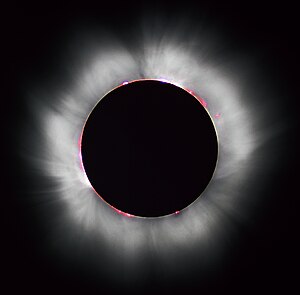
Back Sonsverduistering Afrikaans Sonnenfinsternis ALS Eclix solar AN كسوف الشمس Arabic كوسوف ARY সূৰ্য গ্ৰহণ Assamese Eclís solar AST Günəş tutulması Azerbaijani گونش توتولماسی AZB Ҡояш тотолоу Bashkir
 A total solar eclipse occurs when the Moon completely covers the Sun's disk, as seen in this solar eclipse. Solar prominences can be seen along the limb (in red) as well as extensively the coronal and partly the radiating coronal streamers. | |
 An annular solar eclipse occurs when the Moon is too far away to completely cover the Sun's disk (October 14, 2023). | |
 During a partial solar eclipse, the Moon blocks only part of the Sun's disk (October 25, 2022). |
A solar eclipse occurs when the Moon passes between Earth and the Sun, thereby obscuring the view of the Sun from a small part of Earth, totally or partially. Such an alignment occurs approximately every six months, during the eclipse season in its new moon phase, when the Moon's orbital plane is closest to the plane of Earth's orbit.[1] In a total eclipse, the disk of the Sun is fully obscured by the Moon. In partial and annular eclipses, only part of the Sun is obscured. Unlike a lunar eclipse, which may be viewed from anywhere on the night side of Earth, a solar eclipse can only be viewed from a relatively small area of the world. As such, although total solar eclipses occur somewhere on Earth every 18 months on average, they recur at any given place only once every 360 to 410 years.
If the Moon were in a perfectly circular orbit and in the same orbital plane as Earth, there would be total solar eclipses once a month, at every new moon. Instead, because the Moon's orbit is tilted at about 5 degrees to Earth's orbit, its shadow usually misses Earth. Solar (and lunar) eclipses therefore happen only during eclipse seasons, resulting in at least two, and up to five, solar eclipses each year, no more than two of which can be total.[2][3] Total eclipses are rarer because they require a more precise alignment between the centers of the Sun and Moon, and because the Moon's apparent size in the sky is sometimes too small to fully cover the Sun.
An eclipse is a natural phenomenon. In some ancient and modern cultures, solar eclipses were attributed to supernatural causes or regarded as bad omens. Astronomers' predictions of eclipses began in China as early as the 4th century BC; eclipses hundreds of years into the future may now be predicted with high accuracy.
Looking directly at the Sun can lead to permanent eye damage, so special eye protection or indirect viewing techniques are used when viewing a solar eclipse. Only the total phase of a total solar eclipse is safe to view without protection. Enthusiasts known as eclipse chasers or umbraphiles travel to remote locations to see solar eclipses.[4][5]
- ^ "What is an eclipse?". European Space Agency. Archived from the original on 2018-08-04. Retrieved 2018-08-04.
- ^ Littmann, Mark; Espenak, Fred; Willcox, Ken (2008). Totality: Eclipses of the Sun. Oxford University Press. pp. 18–19. ISBN 978-0-19-953209-4.
- ^ Five solar eclipses occurred in 1935.NASA (September 6, 2009). "Five Millennium Catalog of Solar Eclipses". NASA Eclipse Web Site. Fred Espenak, Project and Website Manager. Archived from the original on April 29, 2010. Retrieved January 26, 2010.
- ^ Koukkos, Christina (May 14, 2009). "Eclipse Chasing, in Pursuit of Total Awe". The New York Times. Archived from the original on June 26, 2018. Retrieved January 15, 2012.
- ^ Pasachoff, Jay M. (July 10, 2010). "Why I Never Miss a Solar Eclipse". The New York Times. Archived from the original on June 26, 2018. Retrieved January 15, 2012.
© MMXXIII Rich X Search. We shall prevail. All rights reserved. Rich X Search